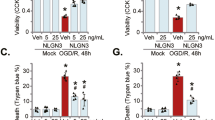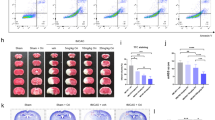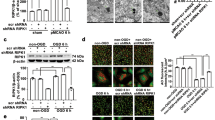Abstract
Dysregulation of Akt signaling is important in a broad range of diseases that includes cancer, diabetes and heart disease. The role of Akt signaling in brain disorders is less clear. We found that global ischemia in intact rats triggered expression and activation of the Akt inhibitor CTMP (carboxyl-terminal modulator protein) in vulnerable hippocampal neurons and that CTMP bound and extinguished Akt activity and was essential to ischemia-induced neuronal death. Although ischemia induced a marked phosphorylation and nuclear translocation of Akt, phosphorylated Akt was not active in post-ischemic neurons, as assessed by kinase assays and phosphorylation of the downstream targets GSK-3β and FOXO3A. RNA interference–mediated depletion of CTMP in a clinically relevant model of stroke restored Akt activity and rescued hippocampal neurons. Our results indicate that CTMP is important in the neurodegeneration that is associated with stroke and identify CTMP as a therapeutic target for the amelioration of hippocampal injury and cognitive deficits.
This is a preview of subscription content, access via your institution
Access options
Subscribe to this journal
Receive 12 print issues and online access
$209.00 per year
only $17.42 per issue
Buy this article
- Purchase on Springer Link
- Instant access to full article PDF
Prices may be subject to local taxes which are calculated during checkout




Similar content being viewed by others
References
Graham, S.H. & Chen, J. Programmed cell death in cerebral ischemia. J. Cereb. Blood Flow Metab. 21, 99–109 (2001).
Lo, E.H., Dalkara, T. & Moskowitz, M.A. Mechanisms, challenges and opportunities in stroke. Nat. Rev. Neurosci. 4, 399–415 (2003).
Liou, A.K., Clark, R.S., Henshall, D.C., Yin, X.M. & Chen, J. To die or not to die for neurons in ischemia, traumatic brain injury and epilepsy: a review on the stress-activated signaling pathways and apoptotic pathways. Prog. Neurobiol. 69, 103–142 (2003).
Zukin, R.S. et al. Molecular and cellular mechanisms of ischemia-induced neuronal death. in Stroke: Pathophysiology, Diagnosis and Management (eds. Mohr, J.P., Choi, D.W., Grotta, J.C., Weir, B. & Wolf, P.A.) 829–854 (Churchill Livingstone, Philadelphia, 2004).
Ouyang, Y.B. et al. Survival- and death-promoting events after transient cerebral ischemia: phosphorylation of Akt, release of cytochrome C and activation of caspase-like proteases. J. Cereb. Blood Flow Metab. 19, 1126–1135 (1999).
Krajewski, S. et al. Release of caspase-9 from mitochondria during neuronal apoptosis and cerebral ischemia. Proc. Natl. Acad. Sci. USA 96, 5752–5757 (1999).
Tanaka, H. et al. Ischemic preconditioning: neuronal survival in the face of caspase-3 activation. J. Neurosci. 24, 2750–2759 (2004).
Zou, H., Henzel, W.J., Liu, X., Lutschg, A. & Wang, X. Apaf-1, a human protein homologous to C. elegans CED-4, participates in cytochrome c–dependent activation of caspase-3. Cell 90, 405–413 (1997).
Colbourne, F., Sutherland, G.R. & Auer, R.N. Electron microscopic evidence against apoptosis as the mechanism of neuronal death in global ischemia. J. Neurosci. 19, 4200–4210 (1999).
Kirino, T. Ischemic tolerance. J. Cereb. Blood Flow Metab. 22, 1283–1296 (2002).
Gidday, J.M. Cerebral preconditioning and ischaemic tolerance. Nat. Rev. Neurosci. 7, 437–448 (2006).
Obrenovitch, T.P. Molecular physiology of preconditioning-induced brain tolerance to ischemia. Physiol. Rev. 88, 211–247 (2008).
Pignataro, G., Scorziello, A., Di, R.G. & Annunziato, L. Post-ischemic brain damage: effect of ischemic preconditioning and postconditioning and identification of potential candidates for stroke therapy. FEBS J. 276, 46–57 (2009).
Yano, S., Tokumitsu, H. & Soderling, T.R. Calcium promotes cell survival through CaM-K kinase activation of the protein kinase B pathway. Nature 396, 584–587 (1998).
Hashiguchi, A. et al. Up-regulation of endothelial nitric oxide synthase via phosphatidylinositol 3-kinase pathway contributes to ischemic tolerance in the CA1 subfield of gerbil hippocampus. J. Cereb. Blood Flow Metab. 24, 271–279 (2004).
Zhao, H., Sapolsky, R.M. & Steinberg, G.K. Phosphoinositide-3-kinase/akt survival signal pathways are implicated in neuronal survival after stroke. Mol. Neurobiol. 34, 249–270 (2006).
Yuan, J. & Yanker, B.Y. Apoptosis in the nervous system. Nature 407, 802–809 (2000).
Dudek, H. et al. Regulation of neuronal survival by the serine-threonine protein kinase Akt. Science 275, 661–665 (1997).
Brunet, A., Datta, S.R. & Greenberg, M.E. Transcription-dependent and -independent control of neuronal survival by the PI3K-Akt signaling pathway. Curr. Opin. Neurobiol. 11, 297–305 (2001).
Parcellier, A., Tintignac, L.A., Zhuravleva, E. & Hemmings, B.A. PKB and the mitochondria: AKTing on apoptosis. Cell. Signal. 20, 21–30 (2008).
Coffer, P.J., Jin, J. & Woodgett, J.R. Protein kinase B (c-Akt): a multifunctional mediator of phosphatidylinositol 3-kinase activation. Biochem. J. 335, 1–13 (1998).
Hresko, R.C. & Mueckler, M. mTOR.RICTOR is the Ser473 kinase for Akt/protein kinase B in 3T3-L1 adipocytes. J. Biol. Chem. 280, 40406–40416 (2005).
Sarbassov, D.D., Guertin, D.A., Ali, S.M. & Sabatini, D.M. Phosphorylation and regulation of Akt/PKB by the rictor-mTOR complex. Science 307, 1098–1101 (2005).
Cross, D.A., Alessi, D.R., Cohen, P., Andjelkovich, M. & Hemmings, B.A. Inhibition of glycogen synthase kinase-3 by insulin mediated by protein kinase B. Nature 378, 785–789 (1995).
Cardone, M.H. et al. Regulation of cell death protease caspase-9 by phosphorylation. Science 282, 1318–1321 (1998).
Yano, S. et al. Activation of Akt/protein kinase B contributes to induction of ischemic tolerance in the CA1 subfield of gerbil hippocampus. J. Cereb. Blood Flow Metab. 21, 351–360 (2001).
Endo, H., Nito, C., Kamada, H., Nishi, T. & Chan, P.H. Activation of the Akt/GSK3beta signaling pathway mediates survival of vulnerable hippocampal neurons after transient global cerebral ischemia in rats. J. Cereb. Blood Flow Metab. 26, 1479–1489 (2006).
Franke, T.F. Intracellular signaling by Akt: bound to be specific. Sci. Signal. 1, e29 (2008).
Maira, S.M. et al. Carboxyl-terminal modulator protein (CTMP), a negative regulator of PKB/Akt and v-Akt at the plasma membrane. Science 294, 374–380 (2001).
Knobbe, C.B., Reifenberger, J., Blaschke, B. & Reifenberger, G. Hypermethylation and transcriptional downregulation of the carboxyl-terminal modulator protein gene in glioblastomas. J. Natl. Cancer Inst. 96, 483–486 (2004).
Maehama, T. & Dixon, J.E. The tumor suppressor, PTEN/MMAC1, dephosphorylates the lipid second messenger, phosphatidylinositol 3,4,5-trisphosphate. J. Biol. Chem. 273, 13375–13378 (1998).
Shaw, J. & Kirshenbaum, L.A. Prime time for JNK-mediated Akt reactivation in hypoxia-reoxygenation. Circ. Res. 98, 7–9 (2006).
Vivanco, I. & Sawyers, C.L. The phosphatidylinositol 3 kinase AKT pathway in human cancer. Nat. Rev. Cancer 2, 489–501 (2002).
Manning, B.D. Balancing Akt with S6K: implications for both metabolic diseases and tumorigenesis. J. Cell Biol. 167, 399–403 (2004).
Hausenloy, D.J., Mocanu, M.M. & Yellon, D.M. Cross-talk between the survival kinases during early reperfusion: its contribution to ischemic preconditioning. Cardiovasc. Res. 63, 305–312 (2004).
Naldini, L. et al. In vivo gene delivery and stable transduction of nondividing cells by a lentiviral vector. Science 272, 263–267 (1996).
Van den Haute, C., Eggermont, K., Nuttin, B., Debyser, Z. & Baekelandt, V. Lentiviral vector–mediated delivery of short hairpin RNA results in persistent knockdown of gene expression in mouse brain. Hum. Gene Ther. 14, 1799–1807 (2003).
Dittgen, T. et al. Lentivirus-based genetic manipulations of cortical neurons and their optical and electrophysiological monitoring in vivo. Proc. Natl. Acad. Sci. USA 101, 18206–18211 (2004).
Lin, J.H. et al. Gap junction–mediated propagation and amplification of cell injury. Nat. Neurosci. 1, 494–500 (1998).
Ono, H. et al. Carboxy-terminal modulator protein induces Akt phosphorylation and activation, thereby enhancing antiapoptotic, glycogen synthetic and glucose uptake pathways. Am. J. Physiol. Cell Physiol. 293, C1576–C1585 (2007).
Noshita, N., Lewen, A., Sugawara, T. & Chan, P.H. Evidence of phosphorylation of Akt and neuronal survival after transient focal cerebral ischemia in mice. J. Cereb. Blood Flow Metab. 21, 1442–1450 (2001).
Hillion, J.A. et al. Involvement of Akt in preconditioning-induced tolerance to ischemia in PC12 cells. J. Cereb. Blood Flow Metab. 26, 1323–1331 (2006).
Miyawaki, T. et al. Ischemic preconditioning blocks BAD translocation, Bcl-xL cleavage and large channel activity in mitochondria of postischemic hippocampal neurons. Proc. Natl. Acad. Sci. USA 105, 4892–4897 (2008).
Calderone, A. et al. Late calcium EDTA rescues hippocampal CA1 neurons from global ischemia-induced death. J. Neurosci. 24, 9903–9913 (2004).
Ramaswamy, S. et al. Regulation of G1 progression by the PTEN tumor suppressor protein is linked to inhibition of the phosphatidylinositol 3 kinase/Akt pathway. Proc. Natl. Acad. Sci. USA 96, 2110–2115 (1999).
Follenzi, A. & Naldini, L. Generation of HIV-1–derived lentiviral vectors. Methods Enzymol. 346, 454–465 (2002).
Follenzi, A., Sabatino, G., Lombardo, A., Boccaccio, C. & Naldini, L. Efficient gene delivery and targeted expression to hepatocytes in vivo by improved lentiviral vectors. Hum. Gene Ther. 13, 243–260 (2002).
Liu, S. et al. Expression of Ca2+-permeable AMPA receptor channels primes cell death in transient forebrain ischemia. Neuron 43, 43–55 (2004).
Skeberdis, V.A. et al. Protein kinase A regulates calcium permeability of NMDA receptors. Nat. Neurosci. 9, 501–510 (2006).
Acknowledgements
We thank J. Backer and L.K. Kaczmarek for helpful scientific discussions and D.T. Borst for editorial assistance. This work was supported by US National Institutes of Health grants NS46742 and NS45693 (to R.S.Z.) and by a generous grant from the F.M. Kirby Foundation Program in Neural Repair and Neuroprotection. R.S.Z. is the F.M. Kirby Professor in Neural Repair and Protection.
Author information
Authors and Affiliations
Contributions
T.M. and D.O. designed and conducted the experiments, prepared all of the figures and participated in writing the manuscript. K.-M.N. designed experiments and (with A.F.) provided guidance in the cloning of miRNA and cDNA constructs into the lentiviral vector. A.L.-B. carried out western blot and immunoprecipitation experiments. B.A.H. provided the CTMP constructs. A.F. provided the lentiviral vector and wrote the lentiviral methods. R.S.Z. designed experiments, supervised the study and wrote the manuscript.
Corresponding author
Supplementary information
Supplementary Text and Figures
Supplementary Figures 1–8 (PDF 1003 kb)
Rights and permissions
About this article
Cite this article
Miyawaki, T., Ofengeim, D., Noh, KM. et al. The endogenous inhibitor of Akt, CTMP, is critical to ischemia-induced neuronal death. Nat Neurosci 12, 618–626 (2009). https://doi.org/10.1038/nn.2299
Received:
Accepted:
Published:
Issue Date:
DOI: https://doi.org/10.1038/nn.2299
This article is cited by
-
Repair-related molecular changes during recovery phase of ischemic stroke in female rats
BMC Neuroscience (2022)
-
Carboxyl-terminal modulator protein facilitates tumor metastasis in triple-negative breast cancer
Cancer Gene Therapy (2022)
-
TRAF2 protects against cerebral ischemia-induced brain injury by suppressing necroptosis
Cell Death & Disease (2019)
-
Carboxyl-terminal modulator protein regulates Akt signaling during skeletal muscle atrophy in vitro and a mouse model of amyotrophic lateral sclerosis
Scientific Reports (2019)
-
Genome-wide Association Analysis of Eye Movement Dysfunction in Schizophrenia
Scientific Reports (2018)



